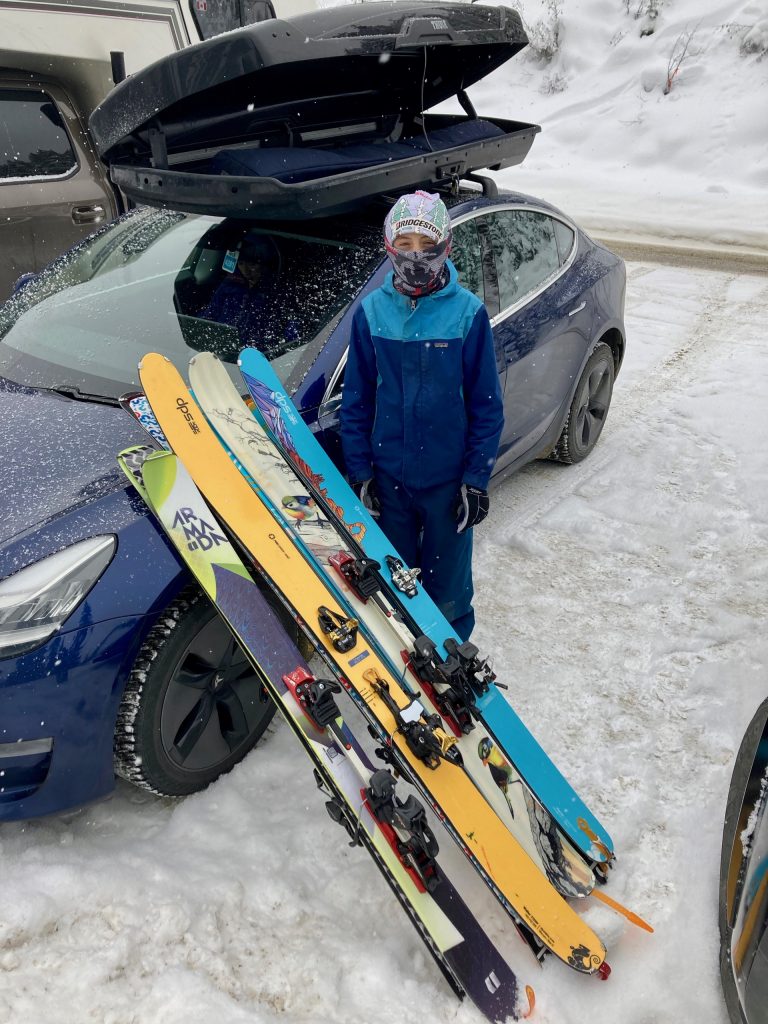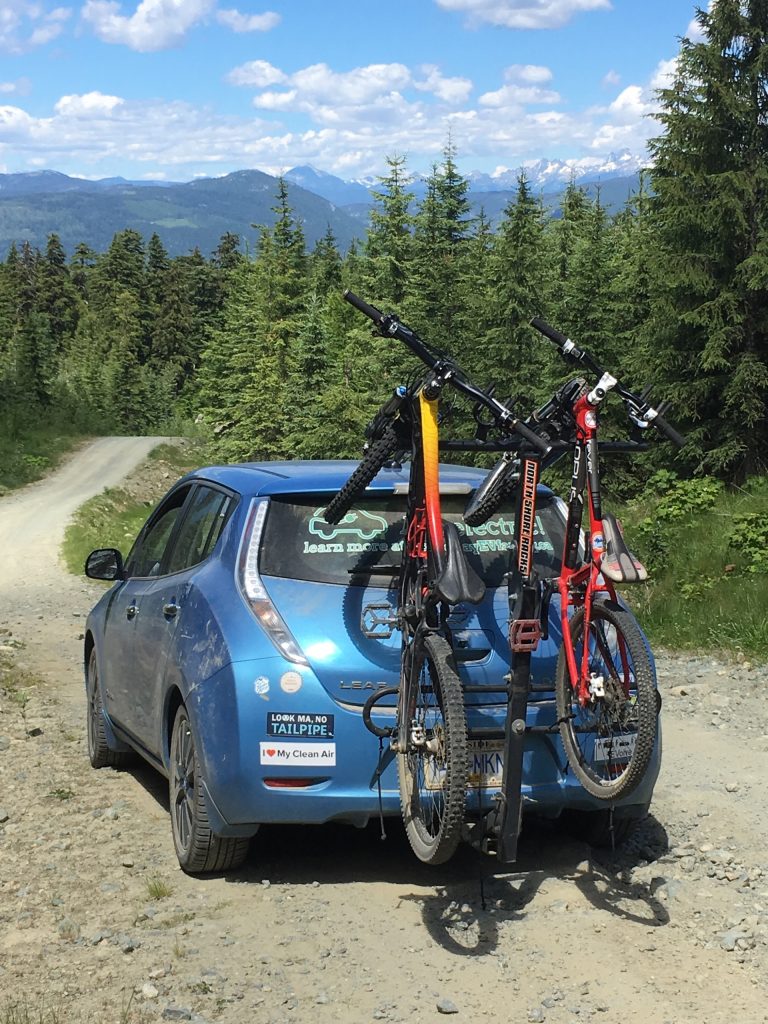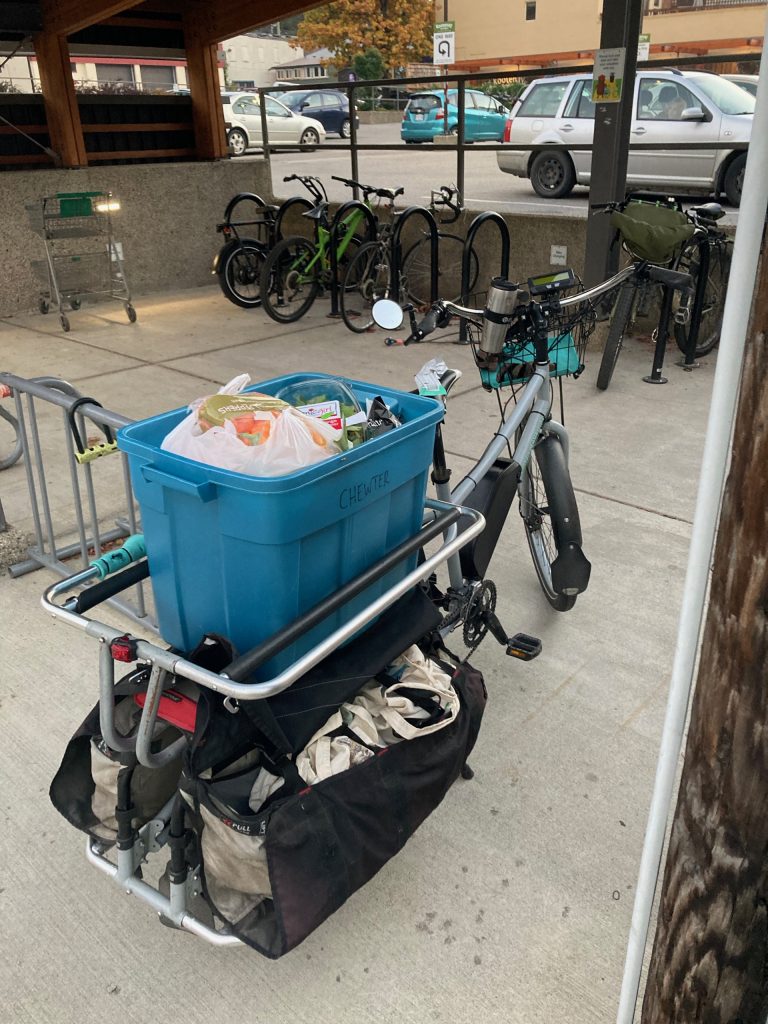The inspiration for this curated list of “EVs for Mountain Towns” came from the various conversations I’ve had with people in my region over the last several years. Many of those conversations went something like “I’m waiting for an EV that can get up my street in winter” or “…an EV that I can take to hiking trails” or “… an EV I can shuttle up Giveout Creek FSR”. For many years, I have demonstrated how you could sort-of do these things with first my Nissan Leaf, then later a Tesla Model 3 (RWD), but now there are several genuine choices that fit the bill much better!
To understand what I mean by a “mountain town” – my context is driven by living in the West Kootenay region of British Columbia for the last decade, where the valleys are deep, the mountain-sides are steep, and a day’s adventure might range from a tight downtown core to driving up 1,000m higher to look down on that same city, before going for a ski tour or a mountain bike ride.


I used to maintain a list of all of the “available EVs in Canada“, but there are too many to list now, so I have created this new list.
With that in mind, I’ve generally picked vehicles I would look at for where I live, and the lifestyle we lead, and the gear that comes with it:
- All wheel drive – there is no substitute for AWD when the roads get steep and you have snow in your area (and winter tires of course!)
- More than average clearance – if you want to be there for “first chair”, or are navigating “rolling-dips” on forest service roads to access a hike, regular car clearance will have you dragging or high-centred
- Needs to be able to carry – 2+ bikes, kayaks/SUPs/canoes, skis
- Any caveats I am aware of that inhibit the above are noted for each car below
So, this post is for all the different mountain towns around the world that have unique transportation realities – maybe this list can help you sort the wheat from the chaff. Please comment below on any vehicles I’ve missed, things you agree or disagree on – what characteristics are important for you for a “mountain town” EV?
…and maybe consider an electric (cargo) bike! Mountain towns are typically constrained by geography, meaning tight downtowns, streets, parking, etc – usually the most practical way to get around, at least during most of the year, is by bike!

Last updated April 22: forgot to include Model Y (!), added tow capacity, added PHEVs, minor grammatical corrections
Cars
Tesla Model 3, Dual Motor with lift kit (MPP kit)
- Check you are getting the Dual Motor version; most of the 3’s out there are RWD (which is actually what we have, and we have managed quite well, but only because we don’t live on one of the more typical steep streets in Nelson)
- With lift kit, has 7.5″ clearance, same as stock Model Y, but sedan form factor (if that’s more your thing)
- Best charging network access
- Caveats: windows tend to freeze in the winter… actually this happens on all cars. The reason this is annoying on the 3 (and Y) is because the windows need to roll down slightly for the door to open, and more importantly, they need to be down and roll back up to close properly (otherwise they jam on the trim). Not rated for towing in North America (1,000 kg in Europe)
CUVs
Audi Q4 / VW ID.4 AWD
- These two cars share the same EV-dedicated platform (same battery and similar drivetrain)
- Reasonable clearance (7″)
- Towing capacity up to 2,700 lbs
- Caveats: hilariously small frunk, just personal preference
Chevrolet Blazer EV (AWD version)
- New Ultium platform from GM, so it should charge very fast
- Wide range of price/performance points
- Caveats: hilariously small frunk (I detect a trend…); low towing capacity (up to 1,500 lbs), not available yet but should be arriving at dealers summer 2023
Ford Mustang Mach-E
- Wide range of price/performance trims
- Well regarded thus far and has been out a few years
- Caveats: not rated for towing in North America (1,500 kg in Europe)
Hyundai IONIQ 5 / Kia EV6 AWD
- Similar to the Q4/ID4 duo above, these two cars share the same platform
- Good price, especially for the features
- Great charging capability
- V2L – handy for power outages (eg fridge)
- Towing capacity up to 2,000 lbs
- Caveats: lower clearance (though you can buy a lift kit), hilariously small frunk
Mercedes EQB350 4MATIC
- Nicely appointed (of course!)
- Caveats: a bit lower range than others on this list, so-so fast charging. Not rated for towing in North America (1,800 kg in Europe)
Nissan Ariya
- Much improved from the Leaf
- Fairly average in all regards
- Caveats: low towing capacity (up to 1,500 lbs)
Subaru Solterra / Toyota BZ4X
- Brands are known for their reliability
- Above average clearance (8″)
- Towing capacity 2,000 lbs (TBC, I haven’t found a reliable source yet)
- Caveats: so-so charging capability (to downright poor on trips where you need more than 2 fast charges), a bit lower range than others on this list
Tesla Model Y
- More featured than most of the direct competition (e.g. passenger power seat + lumbar)
- Reasonable clearance, and easily available lift-kit to increase to just over 9″
- 3,500 lbs towing and 2″ receiver easily available from Tesla
- Best charging network access and highest range in this category
- Caveats: same as the Model 3 above, the window freezing can be awkward in the winter, unless you have a carport or garage to keep most of the snow off
Volvo XC40 Recharge Twin
- Thoughtfully designed with well-sorted interior
- Good safety feats
- Towing capacity 4,000 lbs
- Caveats: a bit lower range than others on this list
SUVs
Everyone will have their own definition of what makes an SUV, but for the purposes of this page, I am going with a vehicle that can comfortably hold 5 people or more, has an enclosed rear space, has clearance exceeding 8″, generally more sophisticated suspension, and can tow 5,000 lbs or more (which is also a general proxy for payload and tongue weight capacity). First up:
BMW IX
- Luxurious of course
- More pavement oriented than the R1S below
- Decent payload (~1400 lbs) and towing capability (5,000 lbs)
- Caveats: other than price, perhaps the limited off-road chops as compared to some SUVs
Rivian R1S
- Will handle pavement, forest service roads and off-roading with equal aplomb due to its sophisticated suspension and various ‘drive modes’
- Big enough to fit a full family (including teens), but small enough to fit into both urban and backcountry parking areas
- Good payload (~1600 lbs), tongue capacity (500 – 770 lbs) and towing capability (5,000 – 7,700 lbs)
- Caveats: more expensive than any of the CUVs, but you really are getting what you pay for here. Other caveat, newer company, so potentially longer wait time, and some may have questions about servicing if you live far from a major metro area
Yep the list is pretty short right now!
Trucks
Ford Lightning
- Decent choice of options and range specs
- Excellent frunk design with a low-load floor
- Good payload (~1,950 lbs depending on options) and towing up to 10,000 lbs
- Excellent power export abilities, with many 120V ports and even a 240V/30A outlet in the bed
- Caveats: it’s a full-size truck, which can be a bit harder to get around mountain areas with due to the length and width
Rivian R1T
- Everything about the R1S above applies, except payload is a bit higher (as high as 1,760 lbs depending on options), and towing is up to 11,000 lbs
- 3 different range options, including one with an estimated range of 640km
- The truck also has a special feature called the ‘Gear Tunnel’, in addition to the frunk
- 120V power ports and onboard compressor
- Caveats: the frunk can be hard to reach for shorter people, as you have to reach over the grille (unlike the Lightning above)
Notable ‘coming soon’ vehicles
Audi Q8 e-tron
Chevrolet Silverado EV
Chevrolet Equinox EV
Ford claims they have new EVs coming in 2024, but as of March 2023, I haven’t been able to find any details on them, or even model names
Fisker Ocean
Honda Prologue
Kia EV9
Lucid Gravity
RAM 1500 REV
Tesla Cybertruck
VW Buzz
Volvo EX90
PHEVs
This list was a bit harder to sort through – some manufacturer’s have “electrified” many models to some degree, but some are pretty minor and have a long list of caveats about when the electric system is insufficient and the gas engine kicks in. To try and limit this somewhat, I picked a few parameters that I thought would be useful, including all-electric range > 50km (to cover majority of daily driving needs) and only mainstream brands, in addition to those set above, e.g. AWD:
- Toyota Rav4 PRIME
- Hyundai Sante Fe Plug-in Hybrid
- Hyundai Tucson Plug-in Hybrid
A few that don’t quite make the cut (due to lower range) include the Jeep Grand Cherokee 4xe, Jeep Wrangler 4xe and Mitsubishi Outlander PHEV
Wondering why <insert preferred car here> didn’t make the list?
Model X: three words, ‘falcon-wing doors’. In my opinion – no good for people/families who need to put something on the roof (e.g. canoe/kayak, skis, storage box, etc), and where I live, a large proportion of ‘outdoor adventure’ folks have a roof box.
Hummer EV: good luck parking that in my town! Or even managing to drive on our narrow forest service roads. Hard pass.
Thanks for an excellent breakdown. As an ID.4 owner I’d like to point out that the AWD Pro S comes with a factory hitch and a towing capacity of 2700 lbs. 🙂
Thanks for pointing that out Chris! I didn’t realize any of the trims came with a hitch included. Is it a 2″ receiver? Does it have a 4-pin trailer connector?
Curiously, despite the relatively high towing capacity, the ID.4 ships with a 1.5-inch receiver (although the factory electrical plug is a 7-pin). Our dealer recommended—and we installed—a 2-inch receiver made for the ID by Curt. Installation was a simple 4-bolt remove and replace. We have a Thule XTR2 rack for our two e-MTBs.
Why is the Tesla Model Y missing from the list? With the hatchback design it’s has plenty of cargo capacity and has an optional factory tow hitch which has a 3,500 tow capacity.
Well that’s embarrassing! Definitely didn’t leave it off intentionally – list updated!
Thanks for all this. Super informative to get your brief notes given your years of experience and research.